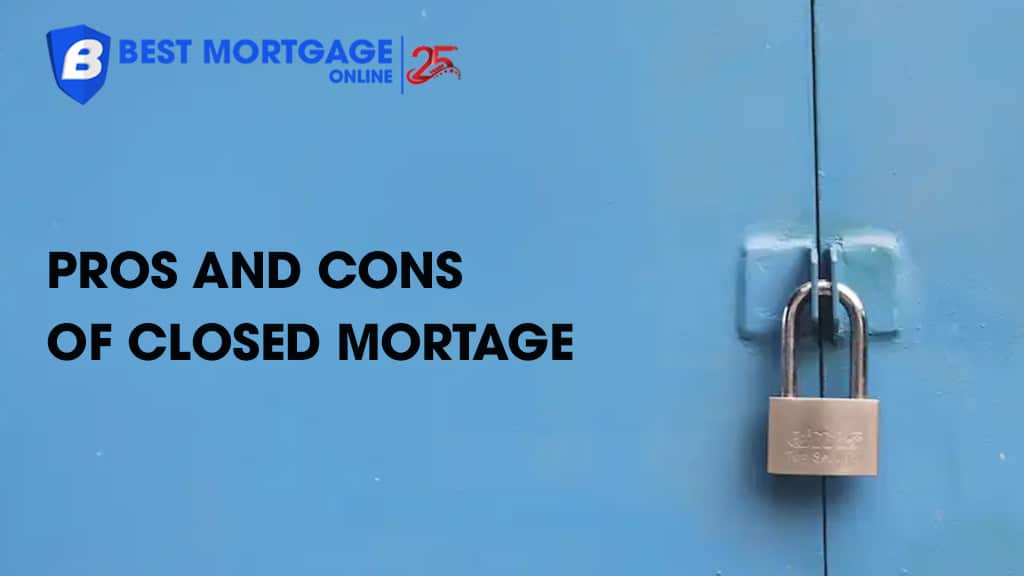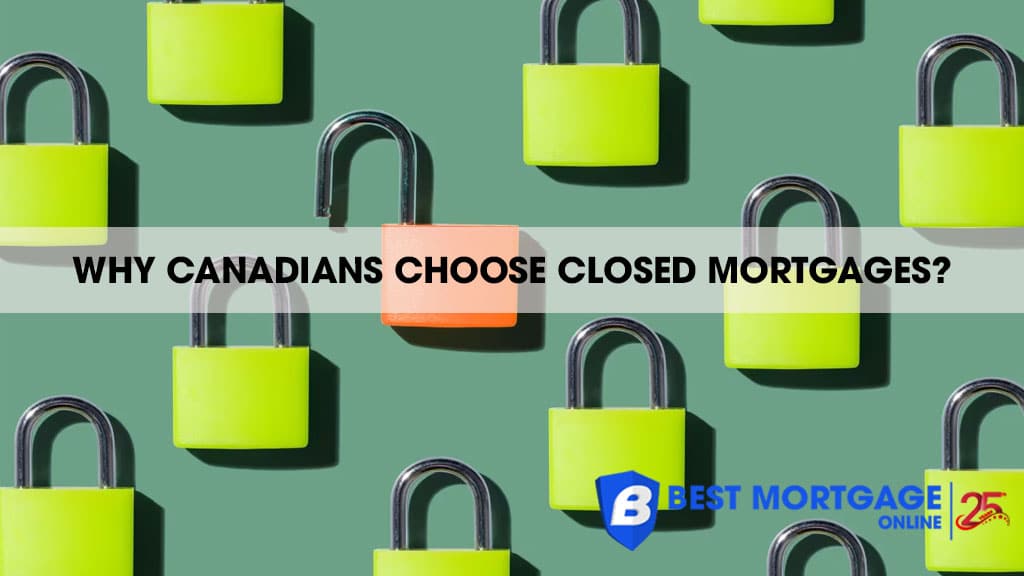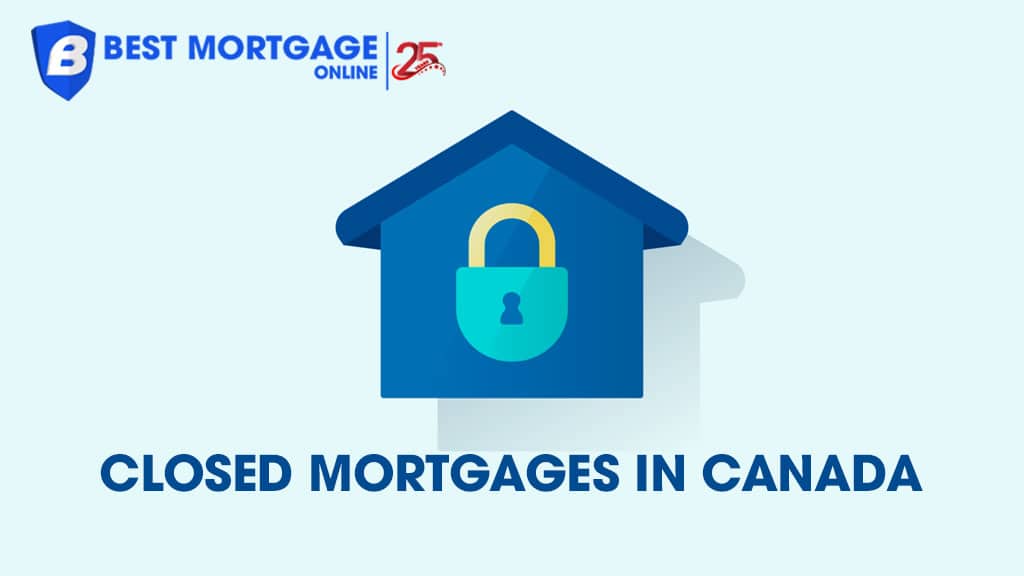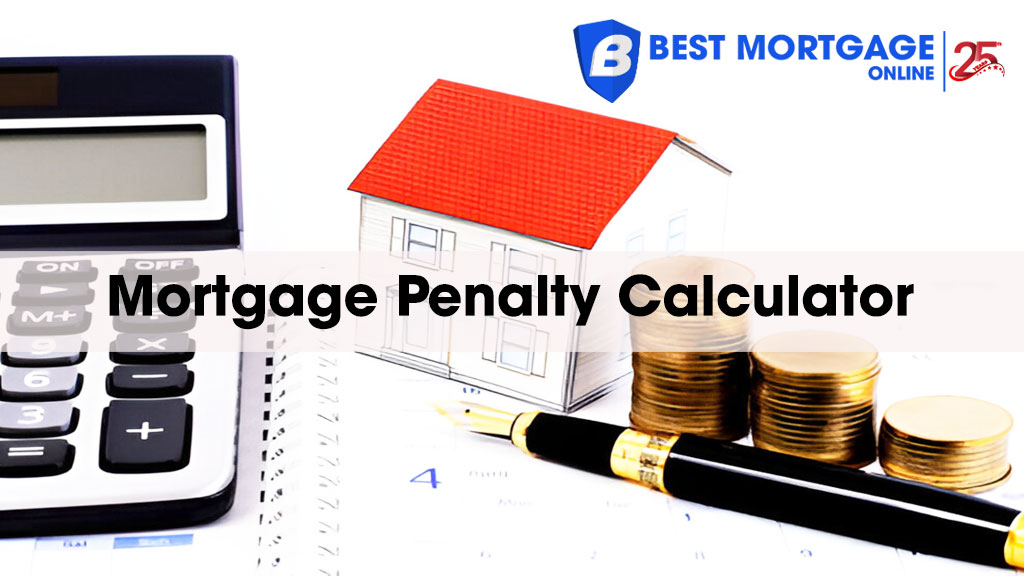Closed mortgages are the most popular mortgage option for Canadian homebuyers. With over 80% of borrowers opting for closed terms, these mortgages dominate the market.
But what exactly are closed mortgages, and why are they so widely used in Canada? This guide will explain everything you need to know about this type of mortgage, from how they work to their advantages and disadvantages. Read on to determine if a closed mortgage is the right choice for your home buying or renewal.
What is a closed mortgage?
A closed mortgage is a type of mortgage that cannot be repaid in full before maturity without prepayment penalties, except as permitted in the mortgage agreement itself.
Most closed mortgages provide some prepayment privileges, allowing lump sum payments of up to 10% (except for some lenders that offer a portion of 15% to 20%) of the original principal annually. However, exceeding these limits triggers stiff prepayment charges from the lender.
How do closed mortgages work?

Closed mortgages provide a lump sum of financing upfront, which the borrower repays through regular principal and interest payments over a set period. The amortization period is typically 25 years (or 30 years for the first-time home buyer), but the mortgage term can range from a few months to 5 years (or more, depending on lenders). The interest rate on a closed mortgage can be fixed for the entire term or variable and tied to the prime rate.
Once the term expires, the mortgage can be renewed at current market rates. These mortgages use the property as collateral, meaning the lender can seize it if the borrower defaults on payments.
Unlike lines of credit or open mortgages, closed mortgages do not allow the principal balance to be reused. Even as regular payments reduce the principal owing, the loan’s original amount cannot be extended or borrowed against again. They are one-time loans that must be fully repaid by the end of the term.
When deciding between open and closed mortgages, the flexibility and prepayment differences are key considerations:
| Open Mortgages | Closed Mortgages |
|---|---|
| Allow prepayment of any amount without penalties Can be easily refinanced at lower rates if rates drop Higher interest rates than closed mortgages Require full monthly amortized payments | Limit prepayments to avoid penalties Lock in an interest rate for the full term Lower interest rates than open mortgages A single lump sum means lower monthly payments |
Ultimately, closed mortgages offer savings on interest costs, while open mortgages provide more flexibility and control.
Beyond open mortgages, other alternatives may make sense depending on your situation:
- Convertible mortgage – This lets borrowers convert to a longer fixed term after a short period, typically 6 months.
- Home equity line of credit – Provides revolving access to funds secured by home equity, with flexibility to repay amounts borrowed.
- Hybrid mortgage – Combines features of fixed and variable mortgages, allowing rate conversion within a single term.
What are the advantages of closed mortgages?

Closed mortgages have six key advantages that make them the most popular mortgage option:
Lower Interest Rates – The biggest appeal is lower interest rates, averaging 1% below open mortgage rates. These interest savings accumulate to thousands of dollars over the mortgage term.
For example, a 5-year fixed-rate closed mortgage currently averages 4.5%, whereas 5-year open mortgages average around 5.3%. On a $300,000 mortgage, this 0.8% rate difference equals $2,400 in savings per year or $12,000 over the full 5-year term.
Rate Protection – Fixed closed terms lock in an interest rate, protecting borrowers if rates trend higher. For instance, by locking in a 3% rate in 2025 for a 5-year term, homeowners protected themselves from rising fixed mortgage rates to over 5% in 2027.
Fixed Payments – Closed mortgages with fixed interest rates have regular, predictable payments that won’t fluctuate. This helps with budgeting.
Lower Fees – Aside from potential prepayment penalties, closed mortgages have lower fees than other products like lines of credit.
Easier Approval – Lenders view closed mortgages as lower risk, so borrowers may find it easier to qualify compared to open mortgages.
Better Cashflow – The single lump sum means lower monthly payments compared to an amortized open mortgage with the same principal.
What are the disadvantages of closed mortgages?
There are also three downsides to be aware of:
Prepayment penalties – Exceeding annual prepayment allowances triggers penalties, as does refinancing before maturity. These penalties can be costly. For example, a homeowner with a $400,000 mortgage at 4% prepays $100,000 over their annual 15% limit may face a penalty of 3 months of interest on the $100,000, costing them $1,000.
Less flexibility – Closed terms lock borrowers in until maturity. Taking advantage of better rates, making large prepayments, or switching lenders is difficult. If rates fall, borrowers forgo savings by being locked in at a higher rate.
Strict terms – Have stricter requirements regarding insurance, loan-to-value ratios, payment frequency, and increasing payments.
Why do Canadians choose closed mortgages?

Over 80% of Canadian homebuyers choose closed mortgages, and for good reason:
- Meet most needs – For most Canadians, the prepayment restrictions are a worthwhile tradeoff for lower rates and big interest savings. Closed terms adequately meet their needs. Most people don’t need the extra flexibility of open mortgages.
- Familiar and accessible – Banks heavily market closed terms. Most buyers stick with what they know and can quickly obtain.
- Stable housing market – Canadian home values are not volatile. Owners don’t need to rapidly prepay mortgages. Closed terms suffice.
- Peace of mind – Canadians value the certainty of fixed repayments. Open mortgages seem riskier or more confusing to many.
Closed mortgage prepayment penalties
Prepayment penalties are the tradeoff that comes with closed-end mortgages in exchange for lower rates. Rules and fees vary between lenders, but penalties generally apply when:
- The annual prepayment allowance is exceeded
- The mortgage is refinanced or switched to another lender before maturity
- The mortgage is paid off in full before the end of the closed term
Understanding the prepayment charges is critical when comparing closed mortgage offers:
- Amount: The higher amount of 3 months of interest or interest rate differential (IRD) on the amount prepaid
- Annual Limit: 10-20% of the original principal
- Term Length: Shorter terms have lower penalties. 3-year terms often have lower prepayment fees than 5 years.
- Variable Rate: Usually smaller penalties than fixed-rate mortgages
Who should consider a closed mortgage?
Closed mortgages are best suited for the following types of borrowers:
First-Time Homebuyers
Many first-time homebuyers gravitate towards closed-end mortgages because they offer lower rates and payments than open mortgages. The predictability of fixed payments also appeals to new homeowners working on tight budgets.
Long-Term Owners
Owners who plan to stay in their home for the long run, such as for 10-25 years or more, benefit from the interest savings of a closed mortgage. Short-term owners would miss out on the entire savings due to potential penalties if they sell before maturity.
Conservative Borrowers
Closed mortgages appeal to fiscally conservative homeowners who are averse to financial risks. The certainty of fixed mortgage payments gives risk-averse borrowers peace of mind.
Retirees and Fixed Income
Retired Canadians living on fixed pensions and other incomes favour the reliability of closed mortgage payments. Sudden payment increases from an open mortgage could severely impact budgets.
First-Time Immigrants
New immigrants from countries with different mortgage systems often gravitate towards the familiarity of closed terms. In comparison, open mortgages seem complex and risky.
Lower Income Households
Borrowers focused primarily on affordability may choose this mortgage type to capitalize on the lowest rates and payments. Rate savings matter more than flexibility.
Qualifying for a closed mortgage
The qualification process for closed mortgages is similar to that of open mortgages. The lender will review:
- Income and employment status
- Existing debts and liabilities
- Credit score and history
- Down payment amount
- Assets and net worth
Meeting the lender’s debt-to-income ratios and minimum credit scores is critical to getting approved. Having a larger down payment and some cushion in your finances also helps improve your chances of qualifying.
Getting pre-approved makes the mortgage search and negotiating process more accessible.
How to find the best closed mortgage in Canada?
Follow these tips when searching for your mortgage in Canada:
- Compare rates to get the most competitive offers.
- Ask about prepayment options to maintain flexibility. Some lenders offer 10-20% annual lump sum allowances.
- Review all fees, such as application, appraisal, and discharge fees. The lowest rate may not be the cheapest overall.
- Consider a blend: A combo of fixed and variable rates or short and long amortization periods can optimize savings.
- Get pre-approved to show sellers you are serious and improve bargaining power.
- Work with a broker to quickly compare many lenders and find you the best closed mortgage.
Whether buying your first home or renewing an existing mortgage, BestMO is here to provide guidance and support. Contact us to take the first step to secure your ideal closed mortgage and see how much you can save today!
FAQs
Should I get a closed or open mortgage in Canada?
Choose closed for lower rates and fixed payments. Choose open if you value the flexibility to prepay, refinance when rates drop, and avoid penalties.
What is the difference between fixed and variable closed mortgages in Canada?
Fixed closed mortgages have a locked-in rate, while variable closed rates float with the prime rate. Fixed rates provide payment stability.
How can I avoid prepayment penalties on my closed mortgage in Canada?
To mitigate penalties, stay within annual prepayment allowances, wait until maturity, or choose a variable rate or short-term closed mortgage.
How do I switch to a different closed mortgage lender in Canada?
You'll need to pay any penalty fees to your existing lender first. Get pre-approved before your term ends for a smooth transition.




